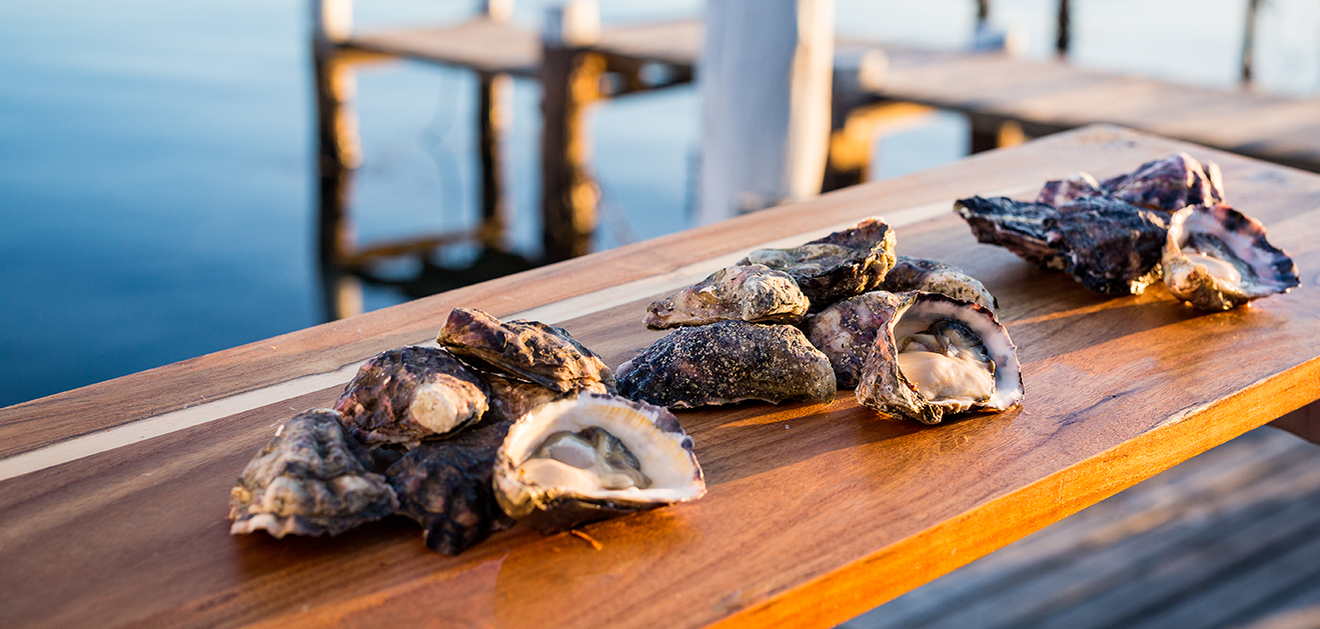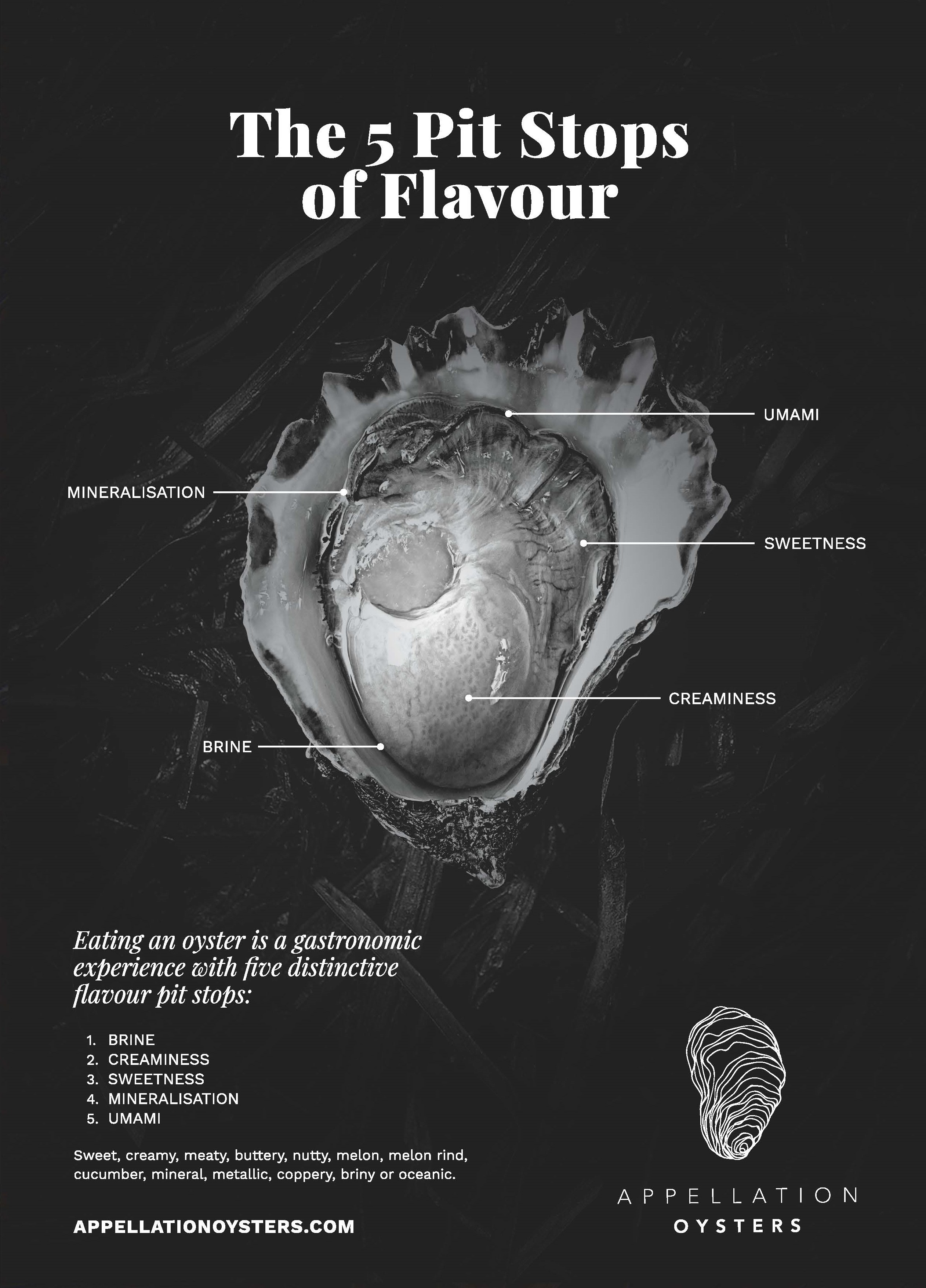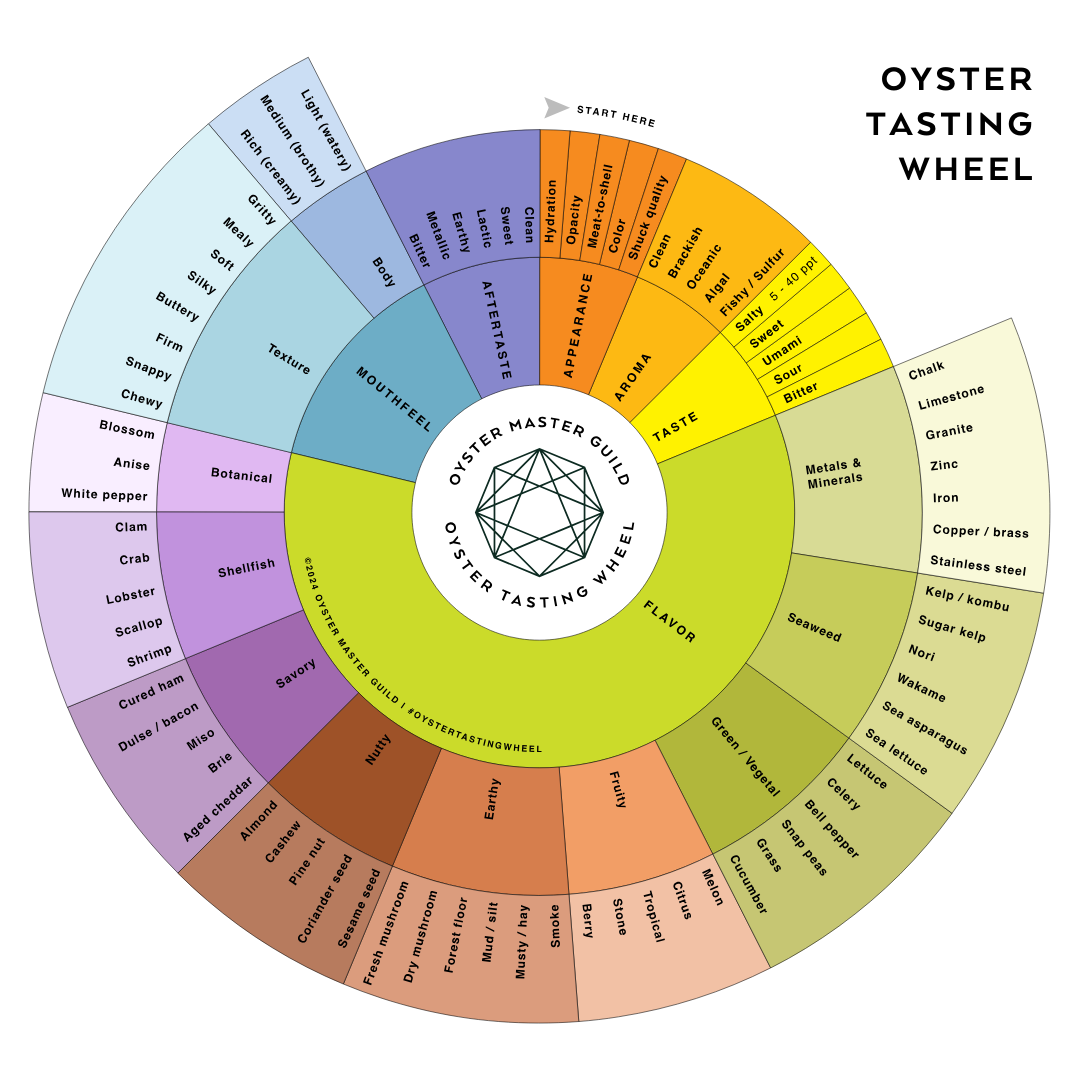How to Taste Rock Oysters Like an Oyster Sommelier
01 September, 2025

01 September, 2025
Great wines have sommeliers. Fine cheeses have affineurs. And when it comes to oysters, the discerning palate demands the same level of attentiveness and respect. To truly appreciate a Rock Oyster, particularly a Rock Oyster awarded Appellation status, you must taste with intention.
At Appellation Oysters, we recognise that flavour is not chance; it is the pure expression of merroir. Each estuary gifts its own signature brine, minerals, sweetness, and depth. To guide you, we use the Five Pit Stops of Flavour, a framework unique to Australian Sydney Rock Oysters, designed to elevate your experience from simple indulgence to refined appreciation.
‘Briny’ or ‘oceanic’ describes the salty flavour that marks the first pit-stop on your oyster journey. After harvest, an oyster holds seawater within its shell to regulate its environment and preserve condition out of the water. The strength of this brine is shaped by the salinity of the marine waters in which the oyster was grown.
Tastes Like: Sea Spray, Olives, Fresh Asparagus
Texture forms the second impression. A velvety or buttery mouthfeel softens the edge of salt, creating a lingering richness. Around ninety percent of a Rock oyster’s flesh is composed of the reproductive gland, meaning creaminess is closely tied to its reproductive cycle. This is influenced by water temperature and the availability of food (algae), both of which drive glycogen (or natural body fat) levels within the Rock oyster. As estuary conditions warm and food becomes abundant, glycogen levels increase, enhancing the oyster’s creamy texture. At peak maturity, when glycogen reserves are optimal, farmers carefully move oysters to holding leases with higher salinity to prevent spawning and preserve their luxurious creaminess until harvest.
Tastes Like: Egg Mayonnaise, Clotted Cream, Cultured Butter, Mascarpone
Sweetness in a Sydney Rock oyster is delicate, sometimes surprising, and always elegant. It provides balance on the mid-palate, softening the sharper edges of brine and mineral. This sweetness is derived from the adductor muscle - the part that joins the top and bottom shells and allows the oyster to open and close. Much like the meat of a scallop, the adductor muscle grows in response to the oyster’s activity. When submerged, the oyster relaxes this muscle to open its shell and filter water; once lifted from the estuary, the muscle contracts to seal the shell and retain moisture. The more frequently an oyster must open and close its shell, the stronger and larger the adductor muscle becomes, delivering a heightened sweetness within the Rock oyster.
Tastes Like: Cucumber, Rock Melon, Watermelon, Green Apple, Clotted Cream
This is where the subtleties emerge. Mineral tones (often flinty, stony, or metallic) reflect the geology and water chemistry of the estuary, revealing the oyster’s true provenance. Mineralisation is most evident on the back palate, shaping the way an oyster ‘finishes.’ Its intensity is determined by the concentration of trace minerals the Rock oyster has absorbed. Elements such as zinc, copper, iodine, and magnesium, naturally present in oceanic waters, impart bright, zingy, mouth-drying notes. These intricate mineral characteristics are distinctive to Rock Oysters, reinforcing their reputation as the gourmet choice.
Tastes Like: Flint, Stone, Iodine, Zinc, Granite, Metallic, Coppery
The final stop is umami: a savoury, mouth-coating depth that lingers long after the Rock oyster has gone. It is the elusive ‘fifth taste,’ first defined in the early 20th century by Japanese chemist Kikunae Ikeda, whose chosen word translates to ‘the essence of deliciousness.’ Unlike sweet, sour, salty, or bitter, umami stands apart as complex, enduring, and deeply satisfying. In oysters, umami is carried in their proteins, shaped by what they ingest from their environment. Organic particles, including detritus from seagrass, infuse the oyster with this distinctive savoury character. Estuaries rich in organic matter can further heighten these notes, adding depth and resonance to the flavour journey. It is umami that completes the tasting experience, inviting reflection and return, and deepening appreciation for the craft of growing Sydney Rock Oysters.
Tastes Like: Nori, Seagrass, Broth, Mushroom, Earthy, Meaty
 Source: https://appellationoysters.com/
Source: https://appellationoysters.com/For those seeking to refine their tasting vocabulary, we recommend exploring the Oyster Master Guild's Oyster Tasting Wheel. This is an internationally recognised tool that provides a structured lexicon for oyster evaluation. From aroma and appearance to flavour and finish, the wheel helps oyster tasters articulate what they perceive with precision.
 Source: https://www.oystermasterguild.com/
Source: https://www.oystermasterguild.com/The Oyster Master Guild also offers online oyster courses, masterclasses, and certification for oyster hospitality professionals and serious oyster aficionados. While these programs are not based on Australian oysters, like the Sydney Rock Oyster, they are exceptional training for anyone wishing to elevate their sensory skills and tasting confidence. As with fine wine education, learning the language of oysters enables you to recognise nuance, compare provenance, and describe flavour with authority.
Appellation Oysters’ Five Pit Stops of Flavour: A Rock Oyster-specific journey through brine, creaminess, sweetness mineralisation, and umami born from oyster growing estuaries in New South Wales.
OMG’s Oyster Tasting Wheel: A structured vocabulary and tasting discipline designed to sharpen your perception and expression.
Together, they form a dual framework, combining experience and language, that will elevate the way you encounter every oyster.
To taste like an oyster sommelier:
Observe: Study the shell, liquor, and flesh. Provenance is first seen with the eyes.
Sip: Begin with the oyster’s liquor. Let the brine awaken your palate.
Taste: Bite once, twice. Allow creaminess, mineralisation, and sweetness to unfold in sequence.
Reflect: Notice the umami finish, the persistence and length of flavour, the subtle differences from one estuary to another.
Articulate: Use the language of the flavour pitstops, complemented by the Oyster Master Guild’s tasting wheel, to give voice to what you have experienced.
An oyster is not just eaten. It is experienced. To taste an Appellation Oyster is to encounter the very best of the daily NSW oyster harvest while discovering oyster merroir and the flavours of NSW's oyster growing estuaries.
Premium Rock oysters deserve to be understood as well as enjoyed. And when you taste them with the attentiveness of a sommelier, you honour not just the oyster, but the estuary and the farmer behind it.
With this framework to guide you, coupled with the right vocabulary, your enjoyment moves beyond indulgence into the realm of mastery.
Want to learn more about our premium Sydney Rock Oysters and the places they’re grown? Explore the Rock Oyster, Australia’s unique native oyster, and discover the flavours of our NSW oyster estuaries in our online Estuary Guide.